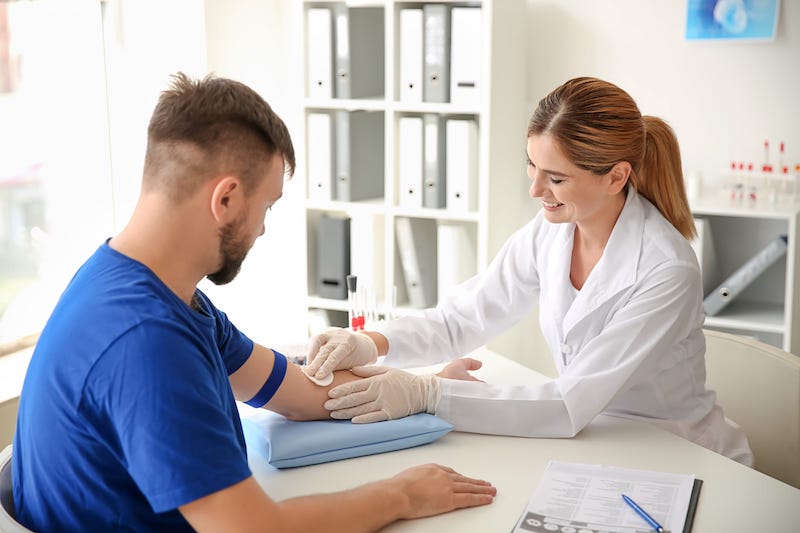The VALID study was designed to investigate Natera’s Prospera blood-based test’s effectiveness in determining the risk that a lung allograft is experiencing either acute rejection or infection. In a wide-ranging Q & A with CLP, David Ross and Justin Rosenheck discuss the goals of the VALID test and the benefits of the blood-based test.
By Chris Wolski
Organ transplantation is one of the miracles of medical science—but they can come with a significant risk to the patient—infection or rejection. For patients facing either of these issues, monitoring and testing them has traditionally been a difficult, resource heavy, costly process involving an invasive lung biopsy.
David Ross, MD, and Justin Rosenheck, DO, sat down with CLP to discuss the VALID study, which was designed to determine the effectiveness of Natera’s Prospera. The blood-based test can determine the risk that a lung allograft is experiencing “tissue injury” due to acute rejection or infection versus quiescence and stability for the allograft.
Ross, Natera’s medical director of lung transplantation and molecular diagnostics, and Rosenheck, a transplant pulmonologist by training and an assistant professor of internal medicine at the Ohio State University, collaborated on the answers to the following questions, which have been edited for length and clarity.
CLP: What are the benefits to patients and to the health enterprise by using a blood-based test to determine allograft rejection or infection?
David Ross and Justin Rosenheck: There are several benefits to blood-based or liquid biopsies that directly improve a patient’s experience with organ transplant monitoring, as well as the healthcare system’s management of transplant care. These tests offer meaningful results that can identify allograft injury in transplant patients. Because of their noninvasive nature, they can be performed remotely, in the comfort of the patient’s home, reducing the logistical burden of traveling to a transplant center for a biopsy and risking exposure to COVID-19 in immune-suppressed transplant recipients. A noninvasive test also reduces the risk of biopsy-related complications and discomfort to the patient. Ultimately, blood-based biopsies give providers an alternative that can reduce the frequency of surveillance biopsies and avoid the costs, labor, and resources that biopsies require.
CLP: What was the goal of the VALID study?
Ross and Rosenheck: The current monitoring paradigm for lung transplant allograft health is imperfect. With nearly half of all lung transplant patients developing chronic rejection of their transplant within five years, there is an existing need among this community for an improved monitoring system for their donor organ. Prospera is validated for use in kidney, heart, and simultaneous pancreas-kidney transplantation. The goal with the VALID study was to investigate the Prospera tests’s efficacy for detection of allograft injury associated with either acute rejection or infection in lung transplant recipients.
CLP: How accurate is the test and do you expect that accuracy to improve as the test is refined or you do more research?
Ross and Rosenheck: No test is 100% accurate. As demonstrated in the VALID study, the sensitivity of Prospera for acute rejection in lung transplants was 89.1% and the specificity was 82.9%. The positive predictive value was 51.9% and, very importantly, the negative predictive value was 97.3%. Therefore, in clinically stable patients who have a low Prospera test result during monitoring, the high sensitivity and negative predictive value should reduce the need for unnecessary surveillance biopsies. Plasma donor-derived cell-free (dd-cfDNA) monitoring, in a short-term monitoring study during the COVID-19 pandemic, had been used to reduce the frequency of transbronchial lung biopsy in a multi-center retrospective study. Prospera is planned for a U.S. multicenter randomized-controlled study (LAMBDA 001 study), investigating noninvasive blood-based monitoring versus standard of care surveillance biopsies after lung transplant.
Zooming out, Natera prioritizes the continuous improvement of all its tests. One example in organ health specifically is Prospera with Quantification, which was recently developed in response to the finding that certain infections can cause elevated total levels of cell-free DNA (cfDNA), thereby artificially changing the donor fraction and hampering the efficacy of the test.
CLP: Walk me through the blood-based test—how does it work?
Ross and Rosenheck: This test is a simple blood draw from a transplant patient that is analyzed in Natera’s CAP-accredited/CLIA lab. It then undergoes a massively-multiplexed PCR-NGS test with complex bioinformatics that analyzes a select panel of single nucleotide polymorphisms (SNPs) that differ between donor and recipient cfDNA.
CLP: We discussed in an earlier call about the sheer number of resources both in terms of personnel and material that is involved in getting a tissue biopsy—in real terms what are the economic benefits (both operationally and from a liability perspective) to the healthcare enterprise?
Ross and Rosenheck: Because donor-derived cfDNA (dd-cfDNA) tests are, overall, more efficient than traditional surveillance biopsies, Prospera and similar tools help to alleviate some of the downward pressure on the healthcare system that makes costs to patients and payers so high. To better understand the resources and labor involved, let’s look at the typical traditional biopsy as a case in point.
The procedure itself takes about 15 minutes and requires a pulmonologist, one or two respiratory therapists, an anesthesiologist, and a nurse anesthetist. It also requires the use of disposable medical goods, in addition to a bronchoscope and fluoroscopy. Afterward, the patient recovers under the care of a post-anesthesia nurse and then is cleared to go home if the individual is stable. While we cannot comment on costs as they will vary, the amount of time and resources for a 15-minute, in-patient procedure are extensive.
A blood draw, on the other hand, requires far fewer steps and time to accomplish the same ultimate goal of testing for organ rejection. In a healthcare system that, currently, constrains physicians and nurses with extremely limited time, the replacement of surveillance biopsies with blood draws, when appropriate, would create a positive ripple effect and allow healthcare professionals to spend more time on higher-impact endeavors.
CLP: I can certainly see a blood test instead of a biopsy becoming the norm. How would a shift from a tissue biopsy to a blood-based testing paradigm change the way care is delivered to the patient?
Ross and Rosenheck: Overall, blood biopsies are much more patient-friendly compared to traditional biopsies. They can be performed more frequently and for a longer duration to get a greater granularity of transplanted organ health trends. Blood biopsies are not able to tell a physician if there are any anatomical defects in the transplant or what type of infection/injury a patient may have. However, their application in clinical practice may allow a physician to stratify which patients will require an invasive test.
In addition to the direct benefits of the noninvasive nature of the test, blood biopsies also allow for remote monitoring of organ transplant patients through mobile phlebotomies. These services reduce costs and logistics—such as those associated with the hassle of making child care arrangements and traveling to and from transplant centers—and allow for fewer missed appointments and better adherence to schedules. More importantly, organ transplant patients are immunosuppressed due to required medication. Therefore, remote monitoring is a viable alternative for patients looking to avoid risky hospital visits, especially during the pandemic.
CLP: The one thing that the VALID study suggests to me is that the lab is going to become a more front-and-center part of the post-lung-transplant care continuum. Broadly, do you see testing of all types—from simple saliva-based testing to next-generation sequencing–becoming the first tools physicians and pathologists are reaching for? If so, how do you think healthcare enterprises should respond in the near and long term?
Ross and Rosenheck: The relative ease of obtaining results from a noninvasive test has the potential to make surveillance testing ubiquitous and more broadly available in the future. Increasing the availability of molecular tools in the clinician’s armamentarium, in addition to standard of care monitoring, should translate into earlier diagnosis, treatment, and clinical outcomes. Companies can respond by making noninvasive tests more accessible through several different avenues, such as:
- Advocating for inclusion of dd-cfDNA testing in official guidelines to bring about physician and patient awareness, and to educate them not only on dd-cfDNA testing, per se, but also on the ideal patient profile for this test. This is important since many physicians and patients may be uncertain about when ordering Prospera is appropriate.
- Investing in peer-reviewed research and large-scale studies—which can be used to verify efficacy and as evidence to justify reimbursement for patients—will also widen access. For example, Prospera has been granted a foundational local coverage determination by the Centers for Medicare and Medicaid Services in 2021 for all organ transplants, which guarantees coverage in several states.
Chris Wolski is chief editor of CLP.





